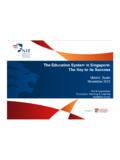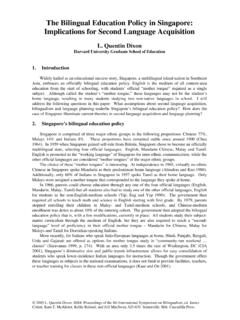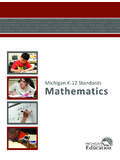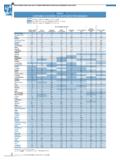Transcription of The Education System in Singapore: The Key to its …
1 The Education System in singapore : The Key to its Success Madrid, Spain November 2011 Prof S Gopinathan Curriculum, Teaching & Learning Academic Group How did singapore transit from Third World to First World in four decades, and what role did Education and training play in this? Became independent in 1965 Small island: 710 sq km Population: million A multi-ethnic society: Chinese ( ), Malay ( ) Indian ( ), other races ( ) No natural resources, very dependent on trade GDP per capita: US$516 (1965); US$43,867 (2010) GDP growth in 2010: [Expectations for rest of the decade is 5%] Manufacturing (of GDP): 28% Savings rate (to GDP): 50% (estimated) Expenditure in R&D: S$ billion ( of GDP in 2009) No.
2 Of schools / students: 328 / 481,110 Expenditure of Education : S$ ( ) of budget (2010) S$ billion ( ) of budget (2011) (estimated) of GDP (2010) singapore : Key Indicators Build social cohesion out of ethnic diversity, division and political instability Give citizens a stake via job creation, access to quality public goods - housing, health, Education etc. Key State-Building Imperatives Taiwan, South Korea, singapore and Hong Kong were fragile states whose sovereignty was under threat; singapore s fragility is captured in the phrase politics of survival . In singapore , an export-led industrialisation model (1965-1985) with success in attracting FDI proved to be hugely successful.
3 Developmental States in East Asia Ashton et al (1999) identify four characteristic features of the East Asian developmental states: Politico-economic strategy with economic growth as the basis for state s legitimacy Mechanisms to link trade and industry policy to Education and training policy Developmental States in East Asia Centralised control, close alignment between the Education and training System , and labour markets The ability to maintain the links through time High level, multi-agency coordination results in joined up government Developmental States in East Asia singapore s limitations forced it from the beginning to be competitive, give priority to economic growth, develop new institutions.
4 Build human capital before resource distribution. State capitalism is alive, well and productive in singapore . In order to survive, we had always to be competitive. Competition to Welfare In Confucian culture, family and community shared with the state responsibility for welfare. singapore s success as a state is due also to being pragmatic not ideological, emphasising effort and standards of excellence. New institutions, DBS, CPF, EDB, SIA, PSA, HDB, etc. were created to facilitate pro-growth policies. singapore Airlines singapore developed Education policies which emphasise meritocracy, science, mathematics, English.
5 At the post-secondary level, it expanded technology-oriented certificate and diploma courses at well resourced Institute of Technical Education , five polytechnics. Five universities cater to about 28% of the cohort; a cap of 30% is envisaged. Economic to transit from an entrepot economy to an individual one via export-orientated industrialisation (EOI) Social to strengthen unity between the ethnic groups Educational to build an Education System appropriate to emerging socio-political needs singapore s Educational Aims Globalisation s Challenge to singapore s Education and Training Values and Infrastructure How can we understand consequences for Education ?
6 Beyond literacy and numeracy, we need 21st century skills eg problem solving, communication skills etc. We need them for all students. We need capacity to develop new knowledge via R&D and make opportunities for lifelong learning available. Globalisation s Challenge to singapore Education We have to prepare ourselves for a future of intense competition and shifting competitive advantages, a future of ever increasing change where technologies are replaced at an increasing pace. Goh Chok Tong Prime Minister, singapore 1997 singapore s Education Reforms The new mission of the schools is to prepare students to work at jobs that do not yet exist, creating ideas and solutions for products and problems that have not yet been identified using technologies that have not yet been invented.
7 Linda Darling-Hammond Responses to Globalisation We have identified as a key focus the fostering of a culture of innovation and enterprise throughout our Education System . To prepare students for a future of relentless change, schools themselves must keep looking for ways to improve and stay relevant. Schools themselves have to be models of innovative practices. We must remain open to new ideas and approaches, and at times create new approaches or pedagogical methods. Tharman Shanmugaratnam Minister for Education , singapore 2003 singapore s Education Reforms Key Goals singapore s Education Reforms (1987 Present) Big bang Education reforms: 1987 - present Government desired to shift economy from labour-intensive to capital and technology intensive economy.
8 Population was growing, expectations were high and leaders recognised the threat from other low-wage, low-skill economies in the region. singapore s Education Journey Could an efficiency, output driven System meet the needs of a knowledge economy and a democratic society? In order to make a successful economic transition singapore needed: Close linking of manpower and economic priorities An Education System with a strong focus on science and technology English to communicate with investors and to seek export markets A labour force with relevant industrial skills singapore s Education Journey New Initiatives: 1987 - 2011 Towards Excellence in Education Thinking Schools, Learning Nation IT Master Plan 1, 2 and 3 National Education Junior College/Upper Secondary Report Curriculum 2015 singapore s Education Journey Towards Excellence in Education .
9 singapore s rapid school expansion efforts had resulted in standardisation. The Excellence Report which created independent schools (and later autonomous schools) was an attempt to devolve greater management and curriculum authority to schools, as well as to enable the top 20% to benefit from an enriched curriculum. singapore s Education Reforms Thinking Schools Learning Nation: to introduce critical and creative thinking, more diversity in curriculum, greater structural diversity (independent and autonomous schools, school cluster scheme) greater resourcing to encourage bottom up innovation, improvements in teacher Education and service and working conditions.
10 singapore s Education Reforms IT Master Plans: To exploit the potential of information and communication technology to give students access to new information sources and make anytime, anywhere learning possible singapore s Education Reforms National Education : Designed to better acquaint students with their own history, to strengthen civic commitments, and protect and defend singapore s core values singapore s Education Reforms singapore has shifted from a rigid System to a more flexible and responsive System , a System of ladders and bridges. singapore s Education Reforms Diversified Secondary Structure singapore s secondary System provides different tracks and subjects to meet a range of abilities and needs.






